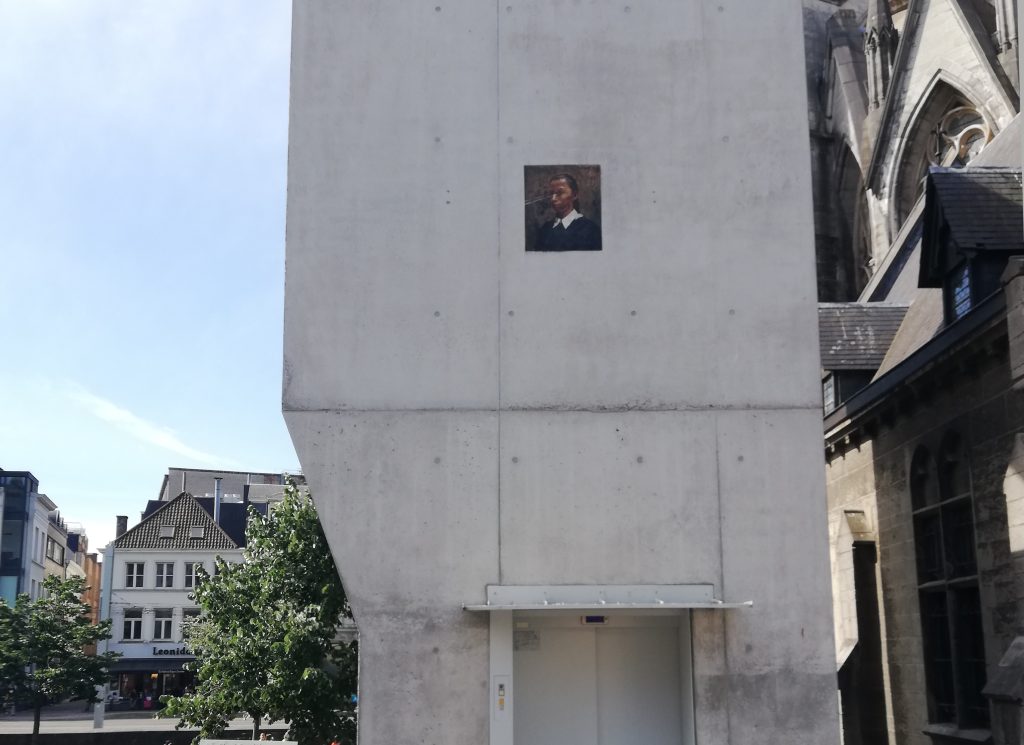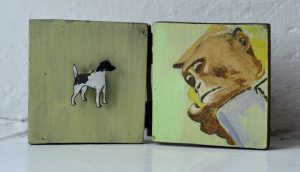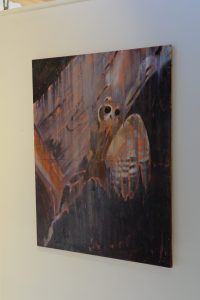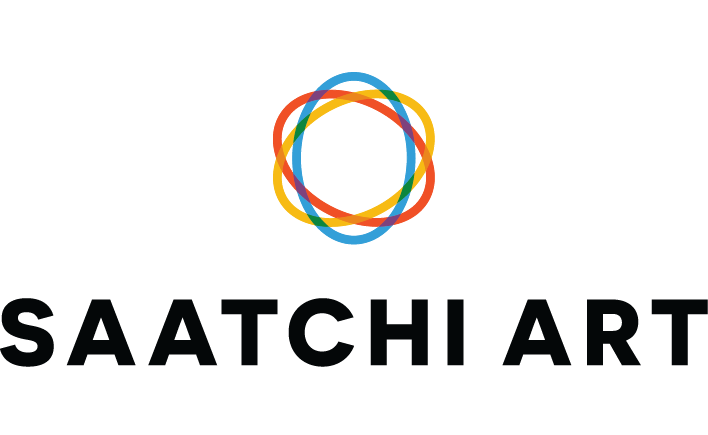Primarily my visit to Ghent was to meet Michael Borremans the contemporary Belgian painter, because his use of photography as a primary painting reference interested me. There is a quiet tension in his work which I admire. Having contacted him through David Zwirner, his gallery, I was lucky enough to get an invite to come to Ghent, where he lives and has one of his studios. Michael and I met for a chat at a pavement cafe next to the flea market in the mediaeval centre of Ghent. We chatted about his show The Acrobat in New York and he presented me with a copy of the catalogue. And I presented him with an antique small metal cone, used to snuff out candles, which I had found in the flea market.
Borremans in his studio photo by Alex Salinas
He had not long returned from New York and was in a holiday mode, ready to go travelling and have time away from his studio. The conversation ranged from what we listen to, or not, whilst we paint. Michael prefers silence and also prefers to keep his consciousness clear of politics and askews the internet, preferring a slower flow of information and news towards him. Not that he is not a political thinker, we talked about world population, Catholic iconography (Michael was brought up a Catholic) and art magazines. His attitude to the latter is not to read them, an opinion I uphold, they can just seem to be from another world, with adverts from top commercial galleries filling most of their pages, and editorial that can be impenetrable. I was assuming that Borremans being one of the larger beasts of the contemporary art scene would be absorbed in that world, but I was wrong. He operates outside it, perpetrating a strong group of art and music friends.
We share a passion for music and in particular vintage guitars and amps, so we had a lot of common ground and I was surprised how at home I felt with him, considering he is such a successful contemporary painter, represented a blue chip, world renowned gallery and I am an emerging artist. He is friends with Luc Tymans and we touched briefly on his upcoming show in Paris, more of him later, although they paint in very different ways Michael and Luc share the fact that they live in Belgium, although Luc lives in Antwerp. There is a painterly but rigorous strand of painting in the contemporary Belgium art scene. Marlene Dumas, Luc Tymans and Michael Borremans all dance to the tune of photographic reference, but interpret it in different ways. Dumas and Tymans share a pared back ‘washed out’ aesthetic, but Borremans with his more ‘old master’ approach is every bit as contemporary as the other two.
Borremans has what he calls a ‘Spanish pride’, stemming from some Hispanic ancestry. As with a lot of artists I meet he was quick to acknowledge his flaws and difficulties, something I find refreshing in a world of perfectly curated glamorous lives posted on Facebook and Instagram by lifestyle influencers.
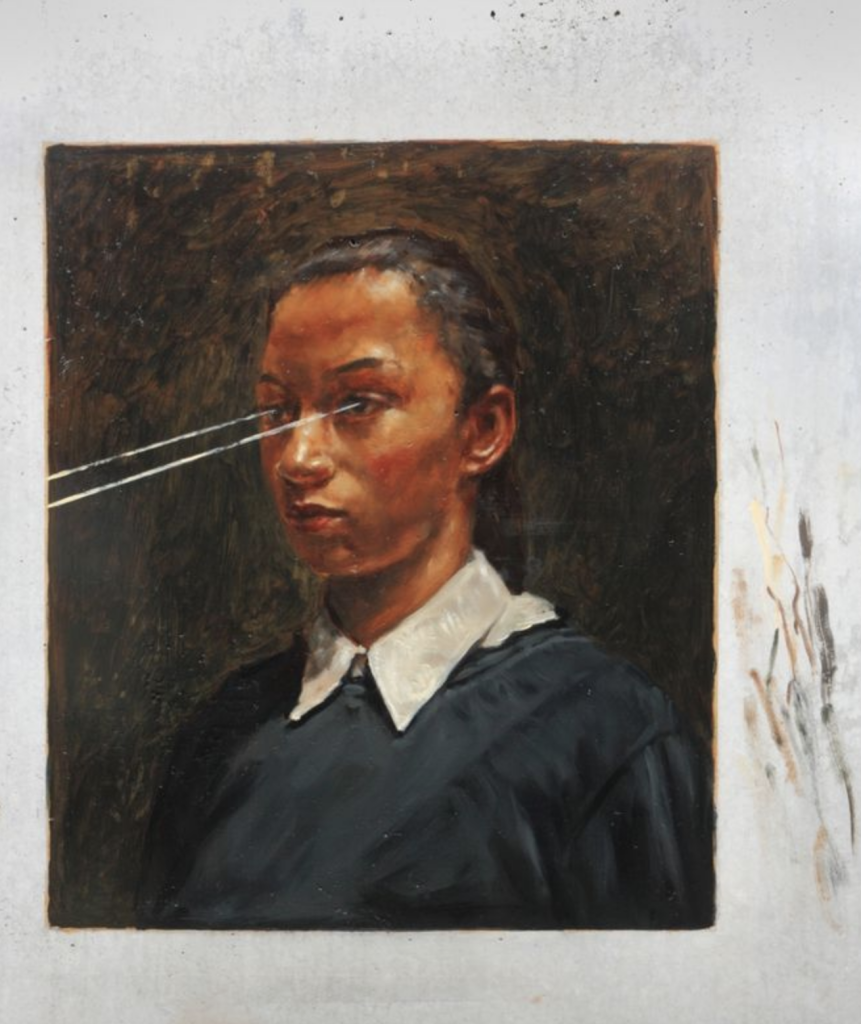
Michael Borremans, The Virgin, De Maagd, 60×70 cm, Oil on concrete
We talked about adding facets to images that don’t appear in the reference image. I asked him in particular about his painting ‘The Virgin’, a painting he gifted to the city of Ghent when a modern brutalist bell tower wasn’t well received. A case of art healing wounds maybe, but a great setting for a painting, I found it by accident, small but assertive, the day before I met Borremans.
The Adoration of the Mystic Lamb, altarpiece, Van Eyck brothers 1432
There is a portrayal of the virgin in the Van Eyck altarpiece ‘The Adoration of the Mystic Lamb’ which is housed in Sint Baafs cathedral only one hundred yards from the belltower. The Van Eyck brothers used rays of light picked out in gold which reign down from the dove of god to people in the painting and to lamb which bleeds into a cup whilst standing on an altar.
The lines coming out of the eyes of Borremans virgin, are to my mind, a modern take on the mediaeval altarpiece, perhaps a comment on post religious individualism and the history of iconography. Borremans would not be drawn on why he had done this, preferring to deepen the mystery. We briefly visited Borremans high ceilinged, huge studio, it has moveable walls and perfect North light from factory style roof lights. He uses artificial lights to make the photographs, which he works from when he paints. Friends and models come and improvise costumes and poses, Borremans loves to paint reflective material, which is a strong element of both Post and mediaeval court and religious portraiture. The richness of a person’s clothes was a status symbol. The wealth of Ghnet and nearby Bruges came from the making of cloth from wool, which came over the channel from Britain. Perhaps this is why the lamb is so central in a literal and physical way in the altarpiece. The lamb has a more ancient history in religious iconography around the idea of gentleness and is mentioned in John 1:29.
I have a lot to thank Borremans for, his generosity with his time and the opportunity to come to Ghent and discover the gallery landscape here, in Antwerp and Paris too. Not to mention meeting Luc Tymans and possibly finding a gallery who just might be interested in my work. I could write a lot more but I am still processing the effects my visit has had on my practice and future.
